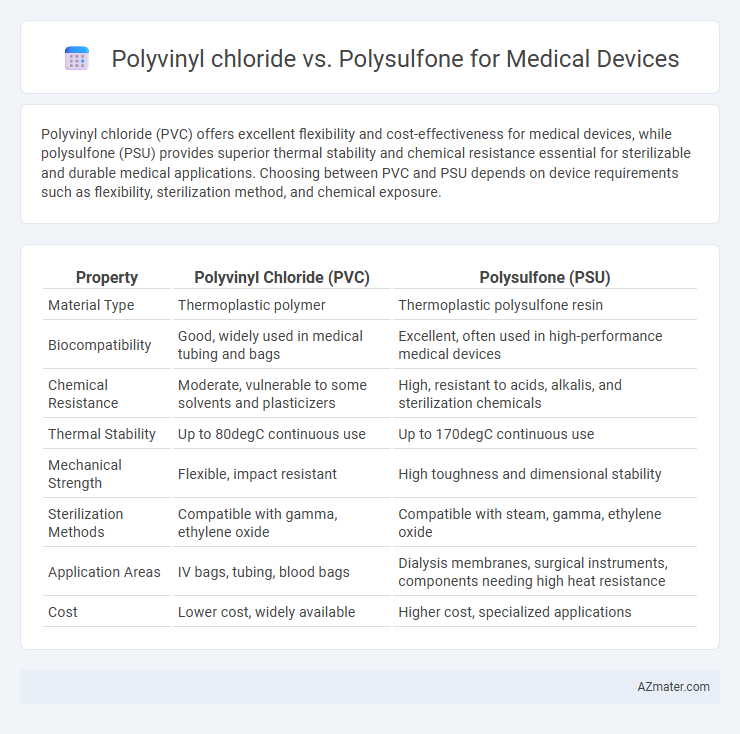Polyvinyl chloride (PVC) offers excellent flexibility and cost-effectiveness for medical devices, while polysulfone (PSU) provides superior thermal stability and chemical resistance essential for sterilizable and durable medical applications. Choosing between PVC and PSU depends on device requirements such as flexibility, sterilization method, and chemical exposure.
Table of Comparison
| Property | Polyvinyl Chloride (PVC) | Polysulfone (PSU) |
|---|---|---|
| Material Type | Thermoplastic polymer | Thermoplastic polysulfone resin |
| Biocompatibility | Good, widely used in medical tubing and bags | Excellent, often used in high-performance medical devices |
| Chemical Resistance | Moderate, vulnerable to some solvents and plasticizers | High, resistant to acids, alkalis, and sterilization chemicals |
| Thermal Stability | Up to 80degC continuous use | Up to 170degC continuous use |
| Mechanical Strength | Flexible, impact resistant | High toughness and dimensional stability |
| Sterilization Methods | Compatible with gamma, ethylene oxide | Compatible with steam, gamma, ethylene oxide |
| Application Areas | IV bags, tubing, blood bags | Dialysis membranes, surgical instruments, components needing high heat resistance |
| Cost | Lower cost, widely available | Higher cost, specialized applications |
Introduction to Polyvinyl Chloride (PVC) and Polysulfone (PSU)
Polyvinyl chloride (PVC) is a widely used thermoplastic polymer known for its excellent chemical resistance, flexibility, and cost-effectiveness in medical device manufacturing. Polysulfone (PSU) is a high-performance thermoplastic characterized by superior thermal stability, biocompatibility, and resistance to sterilization methods such as autoclaving. Both materials offer distinct advantages, with PVC favored for disposable medical products and PSU preferred for reusable devices requiring durability and high-temperature endurance.
Chemical Structure and Material Properties
Polyvinyl chloride (PVC) features a rigid carbon backbone with chlorine substituents that enhance chemical resistance and flexibility through plasticizers, making it widely used in disposable medical devices due to its cost-effectiveness and biocompatibility. Polysulfone (PSU) has a backbone consisting of aromatic rings linked by sulfone and ether groups, offering superior thermal stability, mechanical strength, and resistance to sterilization methods essential for reusable medical devices. The chemical structure of PSU provides higher chemical inertness and transparency compared to PVC, which often requires additives that may affect its long-term durability and performance in critical medical applications.
Biocompatibility in Medical Applications
Polyvinyl chloride (PVC) exhibits good biocompatibility with widespread use in medical devices such as tubing and blood bags, owing to its flexibility and chemical resistance. Polysulfone (PSU) offers superior thermal stability and inertness, making it ideal for high-temperature sterilization processes and applications requiring long-term implant stability. While PVC is prone to plasticizer leaching affecting compatibility, polysulfone's enhanced biostability reduces the risk of adverse tissue reactions in sensitive medical applications.
Mechanical Strength and Durability Comparison
Polyvinyl chloride (PVC) offers moderate mechanical strength and flexibility, making it suitable for disposable medical devices but limiting its durability under high-stress conditions. Polysulfone (PSU) provides superior mechanical strength with excellent impact resistance and thermal stability, ensuring enhanced durability for reusable medical devices exposed to rigorous sterilization processes. The intrinsic toughness and chemical resistance of polysulfone make it a preferred choice for long-term applications requiring reliable mechanical performance.
Sterilization Compatibility and Resistance
Polyvinyl chloride (PVC) exhibits moderate chemical resistance but can degrade or leach plasticizers under high-temperature sterilization methods like autoclaving, limiting its compatibility with steam sterilization. Polysulfone (PSU) offers superior resistance to high temperatures and aggressive sterilization techniques, including steam autoclaving and gamma radiation, maintaining mechanical integrity and biocompatibility. PSU's enhanced sterilization compatibility and resistance make it preferable for medical devices requiring repeated or rigorous sterilization cycles compared to PVC.
Flexibility and Design Versatility
Polyvinyl chloride (PVC) offers superior flexibility due to its plasticized structure, making it ideal for medical devices requiring bendable and soft components. Polysulfone (PSU), while less flexible, provides excellent thermal stability and chemical resistance, allowing for more intricate and durable design applications. The choice between PVC and polysulfone hinges on balancing the need for flexibility with design versatility, particularly in devices exposed to sterilization or harsh chemicals.
Leachables and Additives: Safety Considerations
Polyvinyl chloride (PVC) medical devices often require plasticizers such as phthalates, which can leach out and raise toxicity concerns, posing potential risks for biocompatibility and patient safety. Polysulfone (PSU) offers superior chemical resistance and thermal stability with fewer additives, significantly reducing the risk of harmful leachables in medical applications. Safety considerations favor polysulfone when minimizing additive-related toxicity is critical for long-term implantable or blood-contacting medical devices.
Cost Analysis: PVC vs Polysulfone
Polyvinyl chloride (PVC) offers a cost-effective solution for medical devices due to its lower raw material and processing expenses compared to polysulfone, making it ideal for large-scale manufacturing. Polysulfone, while higher in initial cost, provides superior thermal stability and chemical resistance, which can reduce long-term maintenance and replacement costs in demanding medical applications. Evaluating the total cost of ownership often favors PVC for budget-sensitive projects, whereas polysulfone justifies its premium price through enhanced durability and performance in critical medical environments.
Regulatory and Environmental Impact
Polyvinyl chloride (PVC) remains widely used in medical devices due to its cost-effectiveness and regulatory approvals from agencies like the FDA, but concerns over phthalate plasticizers have led to stricter regulations and environmental scrutiny. Polysulfone exhibits superior chemical resistance and thermal stability, meeting stringent ISO and USP Class VI standards for biocompatibility, while offering greater sustainability by being free of hazardous plasticizers and easier to recycle. Regulatory trends increasingly favor polysulfone for medical applications where reduced environmental impact and enhanced patient safety are priorities.
Choosing the Right Material for Medical Device Applications
Polyvinyl chloride (PVC) offers excellent flexibility, chemical resistance, and cost-effectiveness, making it suitable for disposable medical devices like tubing and blood bags. Polysulfone (PSU) provides superior thermal stability, biocompatibility, and durability, ideal for reusable medical devices requiring sterilization and high mechanical strength. Selecting between PVC and polysulfone depends on specific medical device requirements such as exposure to sterilization processes, required lifespan, and mechanical performance standards.

Infographic: Polyvinyl chloride vs Polysulfone for Medical Device
 azmater.com
azmater.com